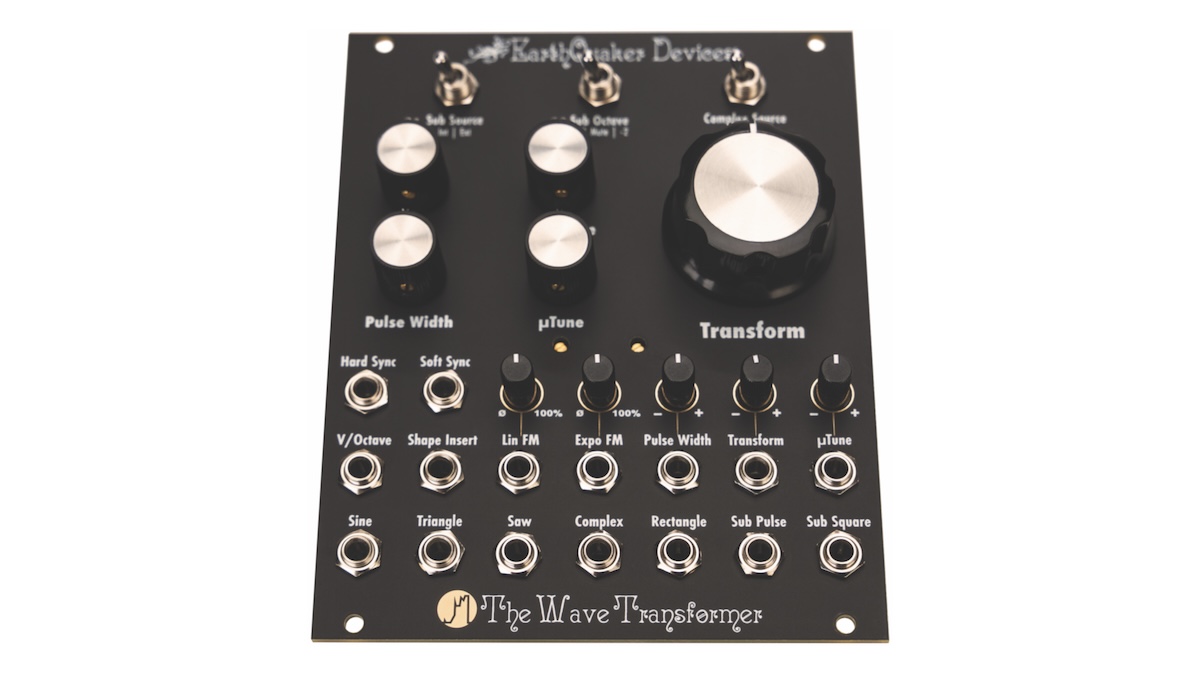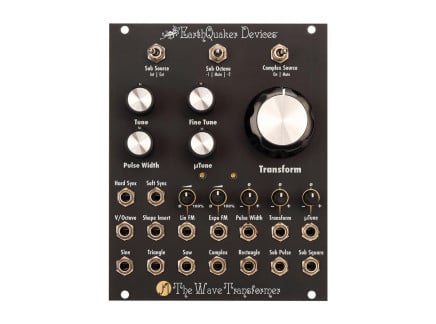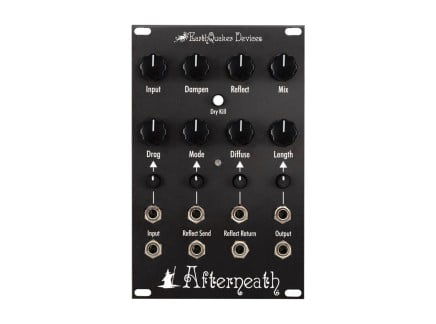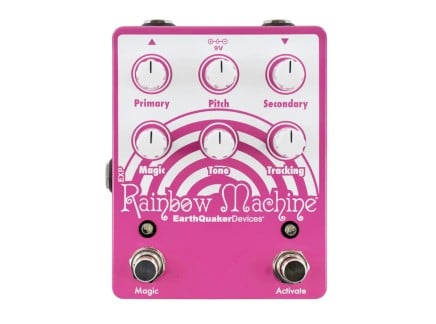After showing the module at Knobcon 2023, EarthQuaker is now officially announcing the release of their newest Eurorack module: The Wave Transformer, an analog oscillator designed to give you extensive tone-shaping options at a very reasonable price (only $199 as of the date of release). The Wave Transformer covers all of the bases you'd expect from a typical analog oscillator—including several variable tone-shaping controls—but it also includes a number of new and novel tricks that give it a sound all its own.
EarthQuaker is, of course, primarily a manufacturer of effect pedals, but as you might recall, in 2020 they released their first Eurorack synthesizer module: a modular adaptation of their reverb pedal, Afterneath. The Afterneath Eurorack module received a quite warm reception, as it represented a step that many of us (myself included) had hoped EarthQuaker would take ever since the release of the Rainbow Machine. The Afterneath quickly became a staple part of many racks, and left us wondering: when would EarthQuaker take their next step?
Of course, many of us expected that EQD's next Eurorack offering would be something similar—an adaptation of another one of their guitar effects. But today, we're faced with a new beast altogether: an EarthQuaker Eurorack module with no precedent in pedal format. Created by module designer Joshua Kolenc, The Wave Transformer is much more than just a mere analog oscillator. While it certainly covers all the usual techniques and tricks of the prototypical analog oscillator, it goes much farther as well, acting as a complex waveshaper and mangler for external signals.
Inquiring minds might like to know that we've teamed up with EarthQuaker and synth-YouTube-and-all-around-good-guy Jorb to give away a Wave Transformer—go here to enter for your chance to win, while the contest is still going!
That said, let's take a closer look to see what The Wave Transformer has to offer.
The Wave Transformer Overview
The Wave Transformer is, as EarthQuaker Devices describes it, a Transfiguration Oscillator—but what does this mean? In so many words, I take it to mean this: The Wave Transformer is an analog oscillator with a wide variety of distinct waveshape outputs (seven of them!) and an enormous number of CV and other tone modification inputs...making it possible to create an astonishing range of ever-shifting sounds.
EQD explains that The Wave Transformer is a complex single oscillator; however, rather than focusing on wavefolding in the tradition of "West Coast synthesis," it uses a new/novel method of wave shaping that results in, I quote, a "gnarled mass of audio mutations." Sick. But, for now, let's take a step back and review some of The Wave Transformer's basic features.
The Wave Transformer is a 100% analog oscillator with all the standard features you could hope for. The fundamental pitch is controlled by a variety of inputs and front-panel parameters—of course, you get the standard coarse and fine tune controls, but in addition, you get a uTune control. The coarse tuning knob has a range of roughly seven octaves; the fine tuning control has a range of roughly one octave; and the uTune control is a very fine tuning control with a range of a mere ~25 cents...great for setting very precise, fine detuning tricks with other sound sources. There's a dedicated 1V/octave pitch CV input, with an accurate tracking range of over eight octaves(!!), making it a trustworthy sound source for tonal use across dang near the entire useful range of "musical" tones. Interestingly, the uTune parameter has its own dedicated CV input with an attenuverter, making it simple to dial in subtle, evolving chorusing effects with external modulation. The uTune CV input has a wider range than the knob itself; an applied CV of 10V would change the pitch by around seven semitones, making it easy to dial in subtle pitch perturbations, momentary bends, or continuously evolving chorusing effects. This is already an immense amount of control, and so far, we've only talked about pitch, and not at all about timbre or some of the more intricate modulation options.
This surprisingly feature-stacked oscillator also features dedicated FM inputs for more drastic pitch-based modulation. It includes both linear and exponential FM inputs, great for all manner of sonic obliteration. Use the linear input if you want a somewhat more subdued flavor of sonic chaos with better preservation of pitch; use the exponential input if you want all-out wild, deeply modulated textures with little regard for tonality. Of course, both the linear and exponential FM inputs can get pretty wild at high modulation depths...but having both flavors accessible simultaneously is a nice touch. It's also worth noting that, as is the custom, the Linear input is AC-coupled, and primarily intended for use with audio-rate signals, whereas the Exponential input is DC-coupled...making it a perfect place to inject gnarly audio-rate modulation or LFOs, random voltage sources, sequences, or other control voltage signals that might benefit from the built-in attenuation option.

So, we know about pitch control and basic modulation options. Let's pause for a second to talk about all of The Wave Transformer's outputs.
Along the bottom of the module, you'll find dedicated outputs for sine, triangle, saw, rectangle, and "complex" shapes (more on the "complex" output here in a minute). Additionally, it features a fixed-width pulse suboctave and square suboctave outputs. The sub square output can be set to -1 octave, -2 octaves, or muted. Interestingly, the sub tones can actually be synthesized from an external source as well—simply switch Sub Source into "External" mode and plug your preferred source into the Shape Insert jack for all manner of suboscillator mayhem. This is not the only place that The Wave Transformer differs from typical analog oscillators—but for now, let's stay on course and get back to the bread and butter features, shall we?
So, we've established that The Wave Transformer has roughly one boatload of distinct audio outputs. It also features a whole slew of inputs...some familiar, and some...not. We've already discussed the various pitch CV inputs; you also get dedicated simultaneous hard sync and soft sync inputs. Additionally, you get a pulse width modulation CV input with dedicated attenuverter, allowing for classic PWM tricks with the rectangle waveshape output. But now, it's time to face the elephant in the room: what the heck is up with that giant Transform knob? And...what the heck is the Complex output all about?

Let's start with perhaps the most basic use case. In its simplest use, the Complex output is a continuously variable output; if the Complex Source switch is set to the On position, the Complex output will produce a triangle wave when Transform is fully counterclockwise. As Transform is increased, the sound is subjected to a variety of nonlinear transformations, continuously increasing in harmonic complexity with ever-changing emphasis on odd and even harmonics and subharmonics. This isn't a wavefolder—it's a new circuit design that wrenches that triangle wave into something utterly gnarly. With the Complex Source switch set to the Mute position, a VCA-like quality is added: with Transform fully CCW, the output is silent, gradually increasing in both loudness and harmonic complexity as the Transform control is turned clockwise. Of course, in either case, the Transform CV input acts accordingly: affecting timbre with Complex Source set to On, and affecting both timbre and loudness when Complex Source is set to Mute.
EarthQuaker describes this effect as being like a "harmonic gate" or "harmonic VCA". This coupling of timbre and loudness is a classic synthesis trick typically approached through filtering processes...but here, EarthQuaker has integrated directly into their oscillator (as in some other Eurorack designs, e.g. Make Noise DPO). That's pretty rad. In fact, you can think of this feature as being somewhat like a low pass gate...but where traditional LPGs are praised for their organic or acoustic-like sound qualities, this sounds altogether crunchier and gnarlier.
But that's not the entire story—a handful of other settings also have an impact on the Complex output. For instance, the Sub Octave switch determines how the Complex output's subharmonics are derived. And, notably, when using the Shape Insert jack, external audio sources can be passed through the Transform circuit to the Complex audio output...allowing The Wave Transformer to act as a shaping tool for external signals. Combine that with the ability to use track external signals with the sub controls, and The Wave Transformer can act as an audio-destroying signal processor more so than as a traditional oscillator. One of the most obvious use cases is to patch one of the oscillator's own outputs into the shape insert jack, allowing you to waveshape signals other than the normalled triangle wave. But, there are some weirder opportunities here as well: if what you're after is some wave-mangling mayhem for external signals, The Wave Transformer is quite ready to grind up your audio and spit it out as something far more intense and peculiar. In this case, it can be incredibly brutal—and we suspect that some of the more adventurous and sonically unhinged of you readers might find great use in conceptualizing The Wave Transformer as a wild waveshaper with an oscillator built in, rather than the other way around. Your mileage, of course, may vary.
And of course, when used with discretion and discipline (both of which I tend to lack), The Wave Transformer is also capable of subtlety and beauty. The sine and triangle outputs are clean and warm; it has an astonishingly wide range of reliable pitch tracking; it has a variety of inputs for subtle control of pitch and timbre. If what you're after is a great-sounding and surprisingly affordable analog oscillator, it'll cover all your bases. If what you want is a somewhat West Coast-esque tool for continuously evolving drones and glistening melodies, it'll easily do that. If what you need is a playground for gnarly, self-patched mayhem, well, it might just be the perfect thing.
Frankly, The Wave Transformer is an exciting development altogether. EarthQuaker Devices have put together an exciting combination of features at an extremely competitive price; in fact, I think it's fair to say that The Wave Transformer is one of the most feature-packed oscillators at its price. It'd make a great choice for beginners looking for a lot of bang for their buck, or for seasoned synthesists seeking a novel new sound-sculpting tool. In short, it's rad, beautiful, and terrifying, and there's nothing else I know that is quite like it.












